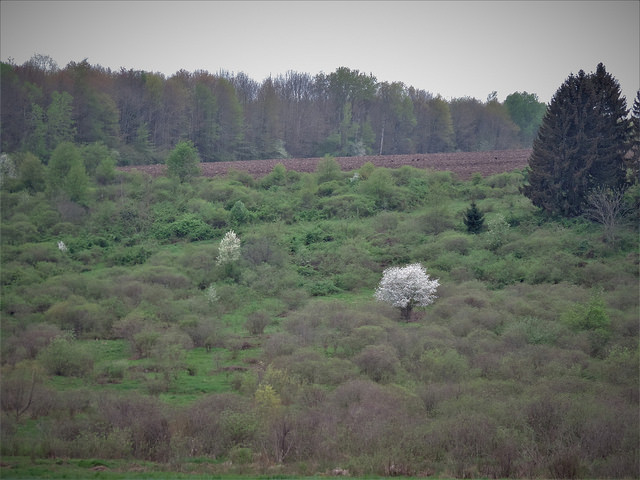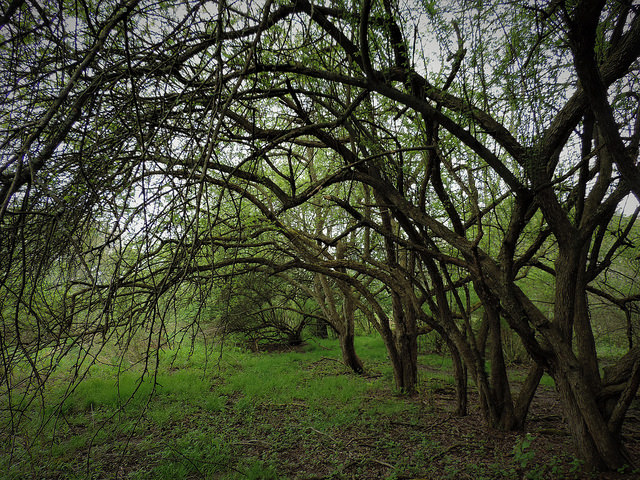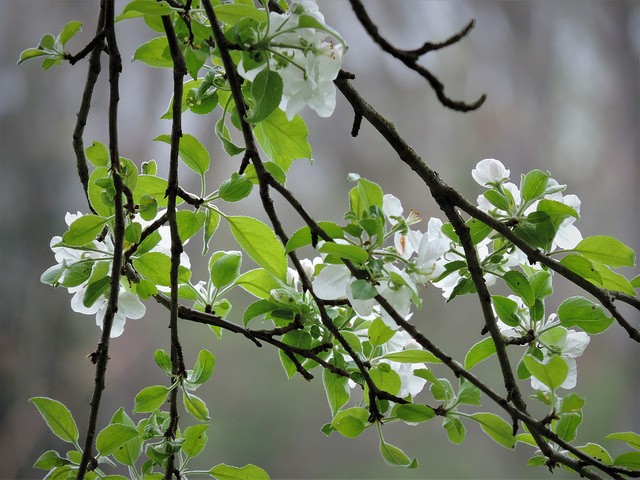The pictures of spring flowers in children’s books are bright pinks, purples and yellows. But look around at all the white flowers – in the fields, on the shrubs and in the trees. And as your eyes scan the landscape and are drawn to the tree in a coat of white, there is a good chance it’s an apple tree. Either planted or wild, apples are in bloom.
Compared to the mighty oak or stately pine apple trees seem common and unremarkable. But I am moved by not only their modest beauty but also to their tenacity and downright practicality in the way their survival is directly tied to humans.

Apple trees stand out in the spring. Photo by Katie Finch
In spring these common trees are robed in whites and pinks. They remind me of snow queens, weddings and cotton candy. Get up close and touch the thin, velvet smooth petals. Curved, symmetrical, arranged in the perfect cluster. They radiate from the center drawing attention in. Maybe you get a little pollen on your finger, half the making of future fruit. Breathe deep and revel in the delicate fragrance. Even the best of perfume is overpowering and artificial compared to apple blossoms in the spring.
Notice the shape of the tree. Such personality. Each one different. Whether the result of pruning by humans or nature, apple branches reach out like arms. On some trees they are gnarly, twisted and ancient arms. On others they are inclusive and comforting like an umbrella in the rain. On others they are dark and secretive.
As I hiked, I paid special attention to the apple trees. Normally, on a warm sunny day, the blossoms would be abuzz with bees and other insects. They drink in the sweet nectar and unknowingly spread pollen from flower to flower, ensuring seeds covered in edible fruit later in the year. But as I walked on this dreary day, too cold for honeybees, I only saw chickadees among the apple branches gleaning insects to eat.

The arch of apple branches create a secret hideout like spot. Photo by Katie Finch
But even as I write this wind and rain are de-robing the apple trees of their beautiful flowers. Petals blow in the wind and litter the ground like confetti after a parade. Is the spring show over? Did the pollinators get their job done before the blooms were rained out? How will the apple crop will be this year?
Nature is so beautiful and so cruel, sometimes in the same moment. Water brings life but also destruction. Bees transfer pollen to make nourishing fruit but also sting. Chickadees sustain themselves by killing another.
How does one survive this? For the apple is comes down to both nature and nurture. Apples are heterozygous. Like a human baby, an apple seed has half the genes from the female (pistil part of the flower) and half from the male (pollen from another flower). But apples have such a wide combination of genes. The tree that grows from that seed may not resemble its parents in the least. Plant an apple tree by seed and it may be like no other apple tree before it. With so many options, apples can adapt to new environments making it suitable for moderate climates worldwide. Approximately 7,500 apple varieties are grown around the world.
Apple seeds can grow on their own but they spread far and wide by hitching their fate to human nurturing. Aside from native crabapples, apples are not native to the United States but to the mountains of Kazakhstan on the border of China. And as people traveled the globe, so did the apple. As Europeans settled America, they brought apples with them.

Apple Blossoms in the rain. Photo by Katie Finch
And the apples with qualities attractive to humans – taste, color, texture, size, usefulness – thrive. But because you can’t get the same tree from a seed, another method is needed. We have delicious apples today because of grafting. When an apple is deemed tasty and useful, a branch of it is cut and attached to another tree or root stock. The McIntosh apple that you enjoy from the store grew on a graft of a graft of a graft, and so on, of a wild tree discovered by a Canadian farmer of the same name in 1811.
We still plant apples today for beautification and human or wildlife consumption. We have domesticated this plant species to our benefit. But there are those trees that are wild and abandoned – the ghosts of humans past. It can take 10 years for an apple seedling to produce fruit. One of the oldest apple trees on record is thought to be over 200 years old. That doesn’t seem old for a tree. But it is old in terms of American history.
As you travel look for the white in the spring. It could be a former homestead, or a place a bear rambled with apples seeds in his belly or a long ago person threw an apple core. Just like pottery shards, apple trees can be artifacts. And later in the year, when that delicately fragrant bloom has transformed to a fleshy fruit don’t hesitate to try one. After all, the Granny Smith was a lucky find in the compost pile of Maria Ann Smith in Australia in 1868.
Audubon Community Nature Center builds and nurtures the connections between people and nature. The trails are open for hiking or skiing from dawn to dusk and the Nature Center is open from 10:00 a.m. – 4:30 p.m. daily except Sundays when it opens at 1:00 p.m. Visit auduboncnc.org for more information or call (716) 569-2345.
Katie Finch is a naturalist at ACNC.


Recent Comments